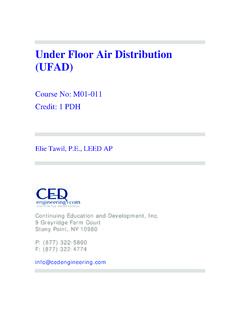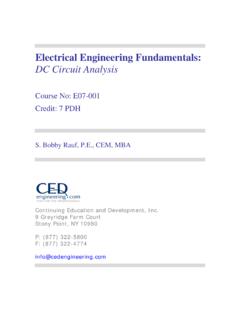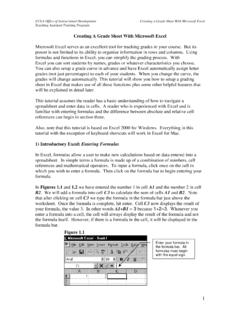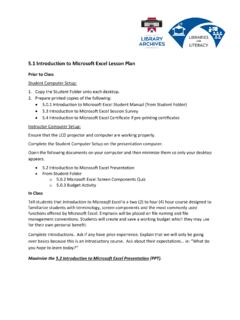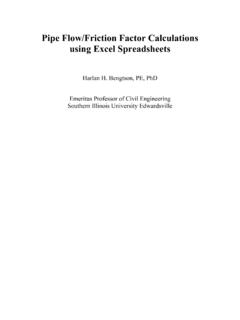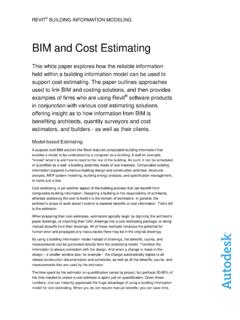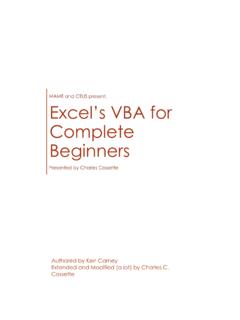Transcription of Finite Element Structural Analysis on an Excel Spreadsheet
1 Finite Element Structural Analysis on an Excel Spreadsheet Course No: S04-003 Credit: 4 PDH Richard Campbell, , Continuing Education and Development, Stonewall CourtWoodcliff Lake, NJ 07677P: (877) Element Structural Analysis ON AN Excel Spreadsheet COURSE DESCRIPTION: Conventional thinking is that Finite Element (FE) Analysis is complex and requires expensive commercial software. This course shows that this is not necessarily true; FE theory can be understood in a few hours and is simple enough to put on an Excel Spreadsheet . Finite Element software is an essential tool for Structural engineers but it need not be complex or expensive.
2 This course will present Finite Element in a simplified Spreadsheet form, combining the power of FE method with the versatility of a Spreadsheet format. The user is provided with a Microsoft Excel Spreadsheet that solves FE two dimensional (2D) frame-type Structural engineering problems. This Spreadsheet is simplistic in comparison to commercial software and much more limited in capabilities, but is completely adequate for many Structural building frame-type problems. I have used the FE Spreadsheet for years and it has been invaluable. It is easy to learn if the user is already familiar with spreadsheets and it is much less expensive than commercial FE software.
3 Conventional FE thinking Spreadsheet -based FE thinking Huge amounts of data & equations Data, equations, results on one Spreadsheet Complex black box algorithms Formulas are all on one Spreadsheet Complex theory, beyond average user Calculation steps and intermediate calculation results all on one Spreadsheet Commercial software is best for handling complex algorithms and complex theory spreadsheets are best for handling huge amounts of data and equations Commercial software is expensive but needed. The FE Spreadsheet is free and most engineers already have the software necessary for spreadsheets .
4 This course is divided into a number of sections, covering: Introduction to FE Definitions and terminology Finite Element examples / applications Finite Element theory Capabilities and limitations of the FE Spreadsheet Summary COURSE OUTLINE: The course introduction provides a description of Finite Element Analysis , as well as some of the typical assumptions underlying Structural Finite Element Analysis . The first portion of the course provides definitions and terminology as they apply to this course. Finite Element Analysis has broad application and in different contexts terms may have different meanings, so this section defines terms as used in this course.
5 The second portion of the course provides a number of FE Analysis examples / applications for Structural engineers. It is important to see applications and results before delving into theory so the purpose of the Analysis is clear, much as it is easier to bake cookies if you are allowed to sample a few before delving into the recipe. The third portion of the course presents some methods to check results. The complexity of many FE problems makes checking a formidable task. Too often, engineers are enamored by the precision of computer generated results and they forget that accuracy is far more important.
6 Checking is about verifying accuracy, not precision. FE method is by nature an approximate solution technique. The fourth portion of the course presents the capabilities and limitations of the FE Spreadsheet provided with the course. All FE methods will have their strengths and weaknesses, their capabilities and limitations. This section illustrates that point with respect to the provided FE Spreadsheet , with the idea that the engineer needs to be aware of similar boundaries for whatever method / software they are using. LEARNING OBJECTIVES. After taking this course, the student will: 1. know the difference between truss, beam and frame-type members 2.
7 Be able to differentiate node data from member data 3. know the difference between local coordinates & global coordinates 4. know some methods to check calculated computer results 5. understand continuous versus discretized systems 6. know the basic assumptions underlying FE theory 7. know some methods to simplify complex FE problems 8. have a basic understanding of the theory used to solve a FE problem 9. understand the transformation of local stiffness values to global stiffness values 10. be able to provide sufficient boundary conditions (supports) for stability 11. understand Microsoft Excel matrix size limitations, and the corresponding FE Spreadsheet problem-size limitations.
8 12. know the benefits, uses and limitations of the provided FE Spreadsheet INTENDED AUDIENCE AND ASSUMED KNOWLEDGE A typical user would be a Structural design engineer working with a beam, truss, frame or elastic foundation problems. The user should: have Excel or higher software. have a working understanding of Spreadsheet formulas (Visual Basic [VBA] programming and macro skills are not necessary). be able to create a Structural 2D frame model with nodes and members. be aware of matrix mathematics (addition, multiplication and inversion of matrices), although detailed knowledge of matrices is not needed.
9 BENEFIT TO THE AUDIENCE This course presents Finite Element in an easy to learn format via a FE Spreadsheet for Microsoft Excel . All of the intermediate steps and intermediate calculated values in example FE problems are easily viewable on the Spreadsheet . Understanding FE theory allows the user to in many cases forego commercial software and use more basic software, such as the FE Spreadsheet . In addition to providing FE theory, this course provides a functional FE Spreadsheet that is versatile, easy to use and easy to understand. It can be used on any computer that has Microsoft Excel ; no license or password or hardware key is required.
10 The Spreadsheet can easily be customized by the user. It can be expanded or modified for specialized problems. It can be adapted from the Structural discipline to other disciplines. It can be shared with others at no cost. INTRODUCTION Finite Element (FE) software is an essential tool for most Structural design engineers, and at the cost of most commercial FE software, it had better be essential. The commercial FE software used by many engineering firms will provide you with more computer-output than you could read in a month and more than you can understand in a year. Commercial programs are great for impressing clients, and great for performing extensive Analysis when really needed.

